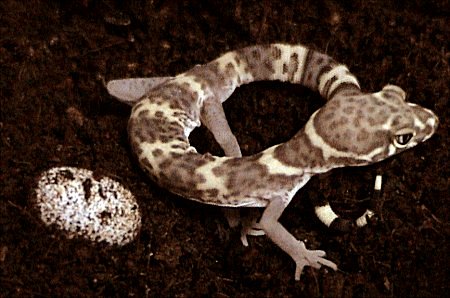New Caledonian Gecko
With A Dual Reputation That of a Lovable Docility and Nasty Biters
Rhacodactylus leachianus is the species name for New Caledonian Giant Geckos. They inhabit both the mainland including the Grand Terre (mainland) which is the largest region and the islands of New Caledonia, namely Pine Isle, Island E, Bayonnaise, Nu Ami, and Nu Ana. These geckos have distinct patterns and body coloration for identification. In terms of size, the New Caledonian geckos are the largest of the species. They are widely popular as pets but have a dual reputation; that of lovable docility and nasty biters. They are arboreal in nature.

Anatomy
The largest member of this genus is the Grand Terre Geckos. Most may grow as big as 17 inches in total length and weigh up to 400 grams. Most vary in size but all are generally smaller than the grand Terre. You can expect the Caledonian giant to have a life span of about 15 years, if you take good care of them.
As a Pet

Food
The New Caledonian Giant geckos are omnivorous. In their natural habitats, they will feed on insects, lizards, rodents, rotting fruits, flowers and leaves. Keeping these geckos is not difficult, as they do not need feeding with live prey. As pets, you should take care to feed them properly with artificially prepared reptile meals such as Tres Reptile Products. Meal Replacement powder (MRP) mixed with water offers a complete nutritious meal that the geckos enjoy. You would do well to dust other foods such as rodents and small insects with calcium and vitamin powder to offer a complete nutrition to the geckos. These giant geckos appear thrilled when you feed them with mice or pinks instead of worms and crickets.
Housing
The New Caledonian Giant Gecko is arboreal, and they will need a height oriented cage and not one that is horizontally oriented. You can house young geckos up to 20 grams in small 10-gallon cages. The adults will require a larger cage. For a single adult gecko a three feet long, two feet wide and four feet tall cage will suit appropriately. Never house two adult males in the same cage since they are extremely aggressive and will fight to death.
Arboreal reptiles love climbing. It is important to offer vertical structures such as bamboo poles, branches and vertically oriented cork flats to create a housing environment that resembles the natural habitat for these geckos.
Substrate
For an aesthetic cage, you can use reptile barks or coco fiber. Cage liners or paper towels may prove as the easiest substrate, especially when housing males and females together during breeding, making it easier to locate (find) the eggs.
Humidity and Water
The New Caledonian Giant Geckos do not need intense grooming. Keep the humidity levels adequate and offer a constant supply of clean and fresh chlorine-free water in a shallow dish that will not topple over.
Temperature and Lighting
Going by their origin, the Giant Geckos will need housing at room temperature in a range of 65 to 80 degrees Fahrenheit. Temperature outside this range will stress them. Provide a 75-watt basking bulb for the geckos to enjoy at will. Since they are nocturnal, lighting requirements are not very specific.
Handling
Allow rough handling to allow these geckos to keep caudal appendage.

Having discovered a fondness for insects while pursuing her degree in Biology, Randi Jones was quite bugged to know that people usually dismissed these little creatures as “creepy-crawlies”.







